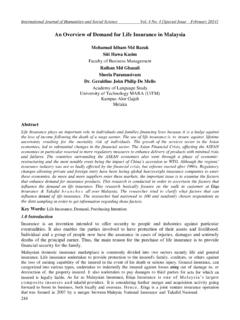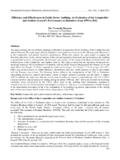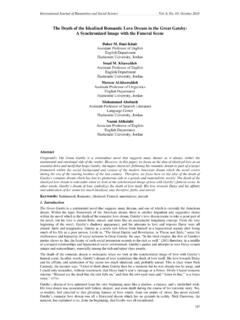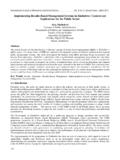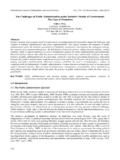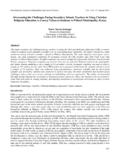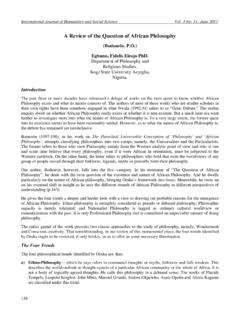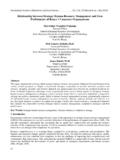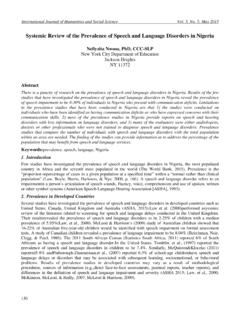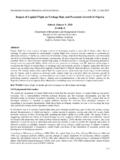Transcription of Effects of Workplace Recreation on Employee …
1 International Journal of Humanities and Social Science Vol. 2 No. 3; February 2012 176 Effects of Workplace Recreation on Employee Performance The Case of Kenya Utalii College Samuel Obino Mokaya Jomo Kenyatta University of Agriculture and Technology Kenya Jackylene Wegoki Gitari Trademark East Africa Kenya Abstract The study sought to determine the effect of Workplace Recreation on Employee performance at Kenya Utalii College. The study covered aspects of job satisfaction, service quality, customer satisfaction, and Employee productivity. The study was descriptive covering a stratified sample of 81 respondents drawn from 162 employees. Data collected through self-administered questionnaire was analyzed using descriptive and inferential statistical tools.
2 The reasons for engaging in Recreation at Workplace were relax mind and feel great ( ), reduce stress and improve concentration ( ), build confidence and self-esteem ( ), and improve health ). Workplace Recreation has a positive influence on Employee performance variables; job satisfaction (92%), quality of service and customer satisfaction (72%) and enhanced productivity ( ). Participation in recreational activities was found to be useful in the management of work-life balance with a correlation of Job satisfaction correlated highly with performance at Employees view Recreation as a form of intrinsic reward; providing a means of pleasure and enjoyment . Staff parties provide suitable opportunity for feedback on performance ( ) and for recognizing Employee achievements ( ); thus meeting Employee s social needs.
3 However, Recreation as a way of influencing employees identity with the organization had very little to do with job satisfaction as explained by a low correlation of Fellowship was the least preferred activity while team building activities were the most preferred. For all respondents, the top three favourite activities were team building, staff parties and aerobics as forms of Recreation . The study concluded that Recreation is a significant factor in Employee performance; increases the level of commitment, enhances bonding and improves Employee wellbeing with a consequent positive effect on job satisfaction, service provision, customer satisfaction and productivity. Therefore, the College and indeed other organizations should offer Recreation facilities and activities that are of interest to employees bearing in mind their different tastes, gender and age among other considerations in order to enhance Employee performance.
4 Key Words: Workplace Recreation , job satisfaction, service quality, customer satisfaction, Employee productivity, Employee performance. Background A key objective of human resource management is to contribute towards the achievement of high level of Employee and organization performance (Armstrong, 2005). Hutchinson, Kinnie, Purcell and Boxall (2003) contend that intangible assets such as culture, skill, competence, motivation and social interaction between people and teams are increasingly being seen as a source of strength in enhancing performance. This is evident in those firms which can combine people and processes together. Organizations therefore need to put in place actions which are aimed at ensuring employees maximize their potential at the work place.
5 As stated by Boxall et al (2003), individual performance is a function of ability, motivation and opportunity (AMO); what they refer to as the fundamentals of Employee s productivity. As part of human resource development, organizations and individuals are slowly appreciating the concept of planning and managing Employee Recreation . American Council on Exercise (2000), contends that creating some leisure time in the course of the day allows employees to recharge themselves psychologically and emotionally and this can lead to improved job performance. There is increased involvement in leisure activities and wellness programmes by companies in a bid to promote employees physical and mental health. Centre for Promoting Ideas, USA 177 According to Taylor (2008), the demand for man made additional resources for Recreation is greater now than before.
6 Though there are many mushrooming of entertainment and sports clubs, many organizations have invested large sums of money to provide such facilities within the Workplace . Kenya Utalii College is one such organization in Kenya that has invested heavily and provides Recreation for its employees. Besides being inherently beneficial to employees, such initiatives can make a significant contribution to reducing absenteeism and raising productivity (Cohen, 1999). Statement of the Problem The hospitality industry is characterized by long working hours; often late at night and very early morning reporting. Much of the work requires employees to be constantly on their feet and customer interactions can be stressful, as employees may be verbally abused for service problems that are none of their doing and completely out of their control.
7 In addition, many of them have problems maintaining a work-life balance. These factors individually or in combination lead to ill-health, low morale, conflicts and high levels of stress. In an effort to help employees cope with such issues, organizations have invested in Workplace Recreation . There is evidence that that Workplace Recreation has a positive effect on Employee performance (WHO, 2003). Workplace physical activity programmes in USA have helped reduce short-term sick leave (by 32%), health care costs (by 20-55%) and increased productivity (by 52%). However, scanty empirical data is available of the situation in developing world (WHO, 2003). Reduction of such kinds of avoidable costs is potentially important, especially in the developing countries such as Kenya as it would lead to higher Employee performance.
8 Kenya Utalii College has established Workplace Recreation in a bid to provide leisure and meet Employee welfare requirements. However, no studies had been conducted to establish is such investments had any changes in Employee and overall organizational performance. Purpose The purpose of the study was to determine the effect of Workplace Recreation on employees performance at Kenya Utalii College. Methods The study adopted a descriptive research design covering a population of 162 employees of Kenya Utalii College. Data was collected from a stratified random sample of 81 (50%) respondents through a semi-structured questionnaire. Quantitative data was analyzed using descriptive and inferential statistical analysis tools; mean and Spearman s rank correlation to determine the relationship between variables under study while analysis of qualitative data involved organization into themes, guided by the study objectives.
9 The analysis helped make a prediction about the dependent variable ( Employee performance) based on its covariance with the independent variables (organizational Recreation ) as supported by Kothari (2004). SPSS computer programme was used in data analysis. Results and Analysis Preliminaries The study achieved a response rate of 77%; of which 60% were male and 40% female. of the respondents over 30 years of age. Majority of the respondents ( %) engaged in recreational activities; once a week, three to four times a week and engaged daily. Regarding preference for various recreational activities fellowship was least preferred at while team building activities were the most preferred at The top three favourite activities were team building, staff parties and aerobics.
10 The reasons for engaging in Recreation were varied; relaxation and feeling great ( ), lose weight ( ), build confidence and self esteem ( ), improve health ( ), relief stress and improve concentration ( ) and passing time ( ). Recreation and Job Satisfaction Most respondents (92%) rated very highly the contention that Recreation has a positive effect on job satisfaction (Figure 1). This implied that if Recreation is well planned and managed it would significantly contribute towards higher levels of job satisfaction and Employee commitment to the organization. Workplace Recreation was seen as a useful strategy in the management of work-life balance with a mean of on a scale of 5. International Journal of Humanities and Social Science Vol.
